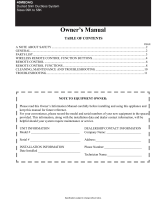Carrier DLFSAB and DLFLAB Owner's manual
- Category
- Split-system air conditioners
- Type
- Owner's manual
Carrier DLFSAB and DLFLAB ductless air handler units provide quiet, maximum comfort for cooling and heating, while also filtering and dehumidifying the air. With a wired controller, wireless remote control, and automatic start-up after a power failure, these units are convenient and easy to use. Energy-saving features like a timer and a clean filter reminder help to reduce energy consumption.
Carrier DLFSAB and DLFLAB ductless air handler units provide quiet, maximum comfort for cooling and heating, while also filtering and dehumidifying the air. With a wired controller, wireless remote control, and automatic start-up after a power failure, these units are convenient and easy to use. Energy-saving features like a timer and a clean filter reminder help to reduce energy consumption.








-
 1
1
-
 2
2
-
 3
3
-
 4
4
-
 5
5
-
 6
6
-
 7
7
-
 8
8
Carrier DLFSAB and DLFLAB Owner's manual
- Category
- Split-system air conditioners
- Type
- Owner's manual
Carrier DLFSAB and DLFLAB ductless air handler units provide quiet, maximum comfort for cooling and heating, while also filtering and dehumidifying the air. With a wired controller, wireless remote control, and automatic start-up after a power failure, these units are convenient and easy to use. Energy-saving features like a timer and a clean filter reminder help to reduce energy consumption.
Ask a question and I''ll find the answer in the document
Finding information in a document is now easier with AI
Related papers
Other documents
-
Bryant 40MCCAQ Owner's manual
-
Bryant 619PHB Owner's manual
-
MRCOOL Ducted Air Handler Heat Kit Install Manual
-
Bryant DHMAHB Owner's manual
-
 Payne 40MBDAQ Owner's manual
Payne 40MBDAQ Owner's manual
-
Klimaire KOIF24H2-1S + KIDF24H2-1S User manual
-
Cooper & Hunter CH-16MMC-230VI Installation guide
-
Bryant 40MBDQ Owner's manual
-
Bryant 40MBDQ Owner's manual
-
Bryant 40MHHC Owner's manual








